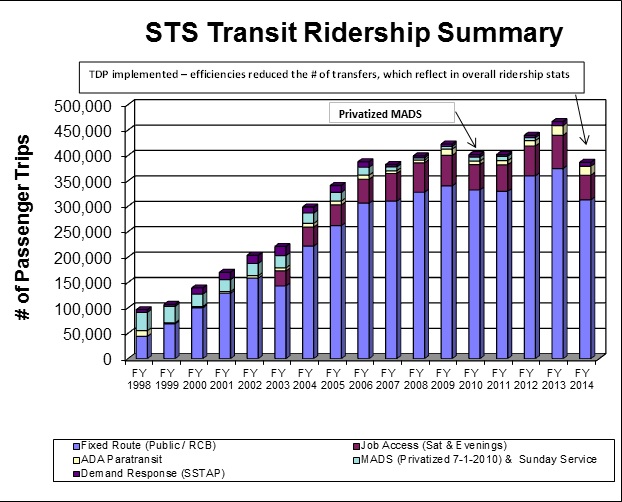SMART Transportation
Commitment
We heard from you and we've made changes to meet your needs better and make your travel more convenient. The main mission of the St. Mary's County Transit Service is to provide Serviceable, Mobile, Accessible Rural Transportation programs for citizens and visitors of St. Mary's County. As such, we have developed diverse and expanding programs which are intended to meet this objective. We hope our programs will allow you more flexibility and options to travel throughout the County. So plan to visit family and friends in the area or enjoy shopping at one of the newly opened centers. We are happy to help you with your transportation needs. Come "RIDE THE BUS WITH US."
Maryland's Transportation System must do more than connect people to places. It must connect people to opportunities.
What Does Transit Do For You?
One of the primary goals is to TRIPLE transit service in Southern Maryland by the year 2020, according to the January 1999 Report of The Transit Advisory Panel Recommendations to the Maryland Department of Transportation Secretary. Some of the benefits of using mass transit can be quantified using: Fuel Savings Calculator, which will you compare the price of using public transportation with the price of paying at the pump and parking your car; Carbon Savings Calculator, which will help you estimate the potential reduction of carbon dioxide emissions you can achieve by switching part or all of your travel to public transportation; and Transit Benefits Calculator, which allows transit supporters to measure the benefits of actual or proposed transit investments in their community. In rural areas, the focus will be on providing basic mobility "lifeline" transit services needed by the elderly and persons who do not have access to, or are not able to use, an automobile. STS ridership growth is reflected over the past several fiscal years as follows:

NOTE: The 18% drop in the number of passenger trips reflected on graph (above) is attributable to the restructuring of routes beginning in October 2013. The STS system improved the efficiency of the public routes as a part of implementing the approved Transportation Development Plan (TDP) recommendations. The efficiencies made riding the STS system more convenient by reducing the number of transfers required by passengers to get to their destination (a 20-25% was anticipated). The statistical reduction in passenger trips is not a reflection in the # of passengers actually utilizing the system.
New buses, good marketing and a willingness to change a route in a heartbeat have been the keys to success for the recently reorganized St. Mary's Transit.
- TRANSIT reduces congestion, saves time and reduces stress.
- TRANSIT promotes economic prosperity.
- TRANSIT encourages tourism and serves major events.
- TRANSIT provides essential public transportation.
- TRANSIT reduces the need for more highways.
- TRANSIT is environmentally friendly.
- TRANSIT supports efficient land use.
- TRANSIT can help achieve Smart Growth policy.
Transit Quality
Unlike transit availability, the kinds of questions weighed by potential passengers when assessing the comfort and convenience of transit service are not necessarily all-or-nothing. Each person assesses the factors that enter into transit quality differently, depending on their own needs and situation. A passenger's decision to use transit rather than a competing mode (when transit is an option) will depend on how well transit service quality compares with that of competing modes. Some of the more important factors that affect transit quality are the following:
- Passenger loads onboard transit vehicles. It is more uncomfortable to stand for long periods of time and the time spent standing cannot be used for more productive or relaxing purposes, such as reading.
- The kinds of passenger amenities provided at transit stops.
- The reliability of transit service. Are passengers assured of getting to their destinations at the promised time, or must they allow extra time for frequent schedule irregularities?
- Door-to-door travel times, relative to other modes.
- The out-of-pocket cost of using transit, relative to other modes.
- Passengers' perceptions of safety and security at transit stops, onboard vehicles, and walking to and from transit stops.
- Whether transfers are required to complete a trip.
- The appearance and comfort of transit facilities.
Mass Transit Administration
St. Mary's County fixed route transit services are included in the MTA January 2000 Maryland Comprehensive Transit Plan. The MTA currently operates between St. Mary's County Regional Airport and the Charlotte Hall Park & Ride Lots along the MD Route 235/5 corridor; extending to Waldorf, in Charles County, MD; eventually into Prince George's County and the District of Columbia via commuter/local bus services.
Days of Operation: Monday through Friday
Time Schedule. Peak Periods
Riders: General Public
Fare Info: Call (410) Senior/Disabled 767-3772
